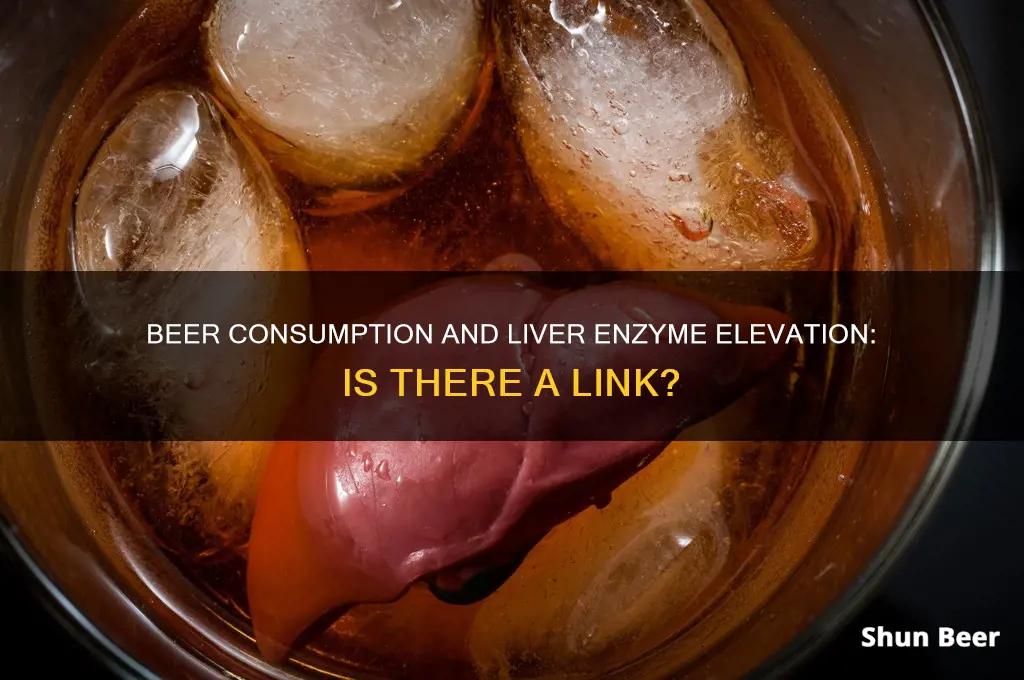
Alcohol is a significant component of the diet with dose-dependent risks and benefits. High doses of alcohol can damage the liver, and early symptoms of liver disease include changes in routinely assessed liver enzymes. The liver is the primary organ responsible for processing alcohol through the body. When you drink to excess, it puts a strain on this vital organ, which can cause inflammation and damaged cells. Even a single night of binge drinking can have a negative impact.
Liver damage from alcohol can be categorised into three stages:
- Fatty liver: the buildup of fat in the liver, which is generally reversible and may not cause serious health problems.
- Alcoholic hepatitis: if heavy drinking continues, the liver can become inflamed, and significant health consequences may occur. This disease is more serious but may be reversed.
- Cirrhosis: the buildup of scar tissue in the liver, which is irreversible and can cause severe illness. If cirrhosis progresses far enough, a liver transplant may be required, or liver failure may occur.
Elevated liver enzymes are a sign of liver inflammation or damage, and alcohol consumption can cause raised levels of certain liver enzymes. However, one study suggests that body weight, rather than alcohol consumption, may be the major factor in determining the serum level of liver enzymes.
| Characteristics | Values |
|---|---|
| Can drinking beer cause elevated liver enzymes? | Yes |
| What are elevated liver enzymes a sign of? | Liver inflammation or damage |
| What are the causes of elevated liver enzymes? | Alcohol consumption, obesity, age, physical inactivity, smoking |
| What are the effects of elevated liver enzymes? | Liver disease, cardiovascular disease, diabetes, cancer, metabolic syndrome, insulin resistance, cardio- or cerebrovascular events |
| What are the early signs of liver damage from drinking? | Tenderness in the area of the liver, unexplained weight loss, nausea or loss of appetite |
| What are the signs of severe liver damage from drinking? | Jaundice, swelling in the ankles and feet, increased sensitivity to illness, ascites, blood in vomit or feces, hepatic encephalopathy |
What You'll Learn

Binge drinking and liver inflammation
Binge drinking is a pattern of drinking that brings blood alcohol concentration levels to 0.08 g/dL. This typically occurs after four drinks for women and five drinks for men within about two hours. Binge drinking is associated with increased violence and accidents, and it is a leading cause of liver-related morbidity and mortality.
Binge drinking produces fatty liver tissue and triggers early stages of inflammation, both indicators of alcohol-induced liver disease. It increases the levels of alcohol-metabolizing enzymes, whose activity can produce oxidative damage and other forms of harm to the liver.
According to a study by the National Institute on Alcohol Abuse and Alcoholism (NIAAA), binge drinking is defined as the consumption of five or more drinks within two hours for men, and four or more drinks in two hours for women. Binge drinking is particularly dangerous because many binge drinkers go on to develop an alcohol use disorder and associated health risks. Excessive alcohol use, including binge drinking, results in about 88,000 preventable deaths yearly in the United States and about 2.5 million years of lost life. Most people with an alcohol use disorder develop fatty liver, and of those, about one in five goes on to develop liver cirrhosis, which is often fatal.
According to a study by UCSF, just 21 binge-drinking sessions in mice were enough to cause symptoms of early-stage liver disease. Liver triglycerides were almost 50% higher in binge drinkers' livers compared to mice that abstained from alcohol, and triglyceride levels in the blood were almost 75% higher. In contrast, moderate-drinking mice and mice that completed just one binge-drinking session did not have significantly elevated triglyceride levels compared to abstainers.
Binge drinking also increases activation of a gene that immune cells use to make an inflammatory cytokine protein called IL-1B, which is implicated in the liver inflammation seen in alcohol-induced liver disease.
It is important to note that the changes to the liver associated with binge drinking may not be completely reversible. Returning to binge drinking after a long period of abstinence may more easily cause harm to the liver.
Ibuprofen and Alcohol: Is One Beer Safe?
You may want to see also

Liver enzymes and alcohol intake
Alcohol consumption can have a significant impact on the liver, and elevated liver enzymes are often used as indicators of liver damage. While there are multiple enzymes in the liver, the most common ones checked for liver function are alanine transaminase (ALT) and aspartate transaminase (AST).
Alcohol and Liver Enzymes
Liver enzymes are proteins that speed up chemical reactions in the liver and play a crucial role in various bodily functions, including digestion and metabolism. When the liver is damaged, these enzymes are released into the bloodstream, leading to elevated liver enzymes. Alcohol consumption, particularly heavy drinking, can cause liver damage and subsequently impact the levels of these enzymes.
Factors Affecting Liver Enzymes
Several factors, including alcohol consumption, obesity, age, physical activity, and smoking, can influence liver enzyme levels. Here are some key findings from various studies:
- A four-year follow-up study found that body weight, rather than alcohol consumption, might be the major factor in determining liver enzyme levels.
- A study from Finland, including 13,976 subjects, showed that male light, moderate, and heavy drinkers had significantly higher relative risks of abnormal gamma-glutamyltransferase (GGT) levels than abstainers.
- A study on mice found that binge drinking increased the levels of alcohol-metabolizing enzymes, which can produce oxidative damage and harm the liver.
- A study using NHANES 2001-2010 data examined the effects of alcohol intake on multiple liver enzymes and found that alcohol consumers had significantly higher levels of AST, GGT, and bilirubin compared to non-consumers.
- The threshold of high risk for alcoholic hepatitis is generally considered to be 3-4 drinks per day over an extended period. Binge drinking, defined as more than 4-5 servings of alcohol in a 2-hour period, can also cause liver damage.
Preventing Alcoholic Liver Disease
Alcoholic liver disease can be challenging to detect in its early stages, as it may not present any noticeable symptoms. Therefore, prevention is crucial. Drinking in moderation, avoiding binge drinking, and maintaining a healthy lifestyle are essential to lower the risk of liver damage. If you are concerned about your liver health or struggling to reduce alcohol consumption, seeking medical advice and support is recommended.
Beer and Finasteride: Is It Safe to Drink Alcohol?
You may want to see also

Liver disease stages
Liver disease progresses in roughly four stages:
Stage 1: Hepatitis
Hepatitis means inflammation in your liver tissues. Inflammation is your liver’s response to injury or toxicity, and it's an attempt to purge infections and start the healing process. Acute hepatitis (an immediate and temporary response) often accomplishes this. But when the injury or toxicity continues, so does the inflammation. Chronic hepatitis causes hyperactive healing that eventually results in scarring (fibrosis).
Stage 2: Fibrosis
Fibrosis is a gradual stiffening of your liver as thin bands of scar tissue gradually add up. Scar tissue reduces blood flow through your liver, which reduces its access to oxygen and nutrients. This is how your liver’s vitality begins to gradually decline. Remarkably, some amount of fibrosis is reversible. Your liver cells can regenerate, and scarring can diminish if the damage slows down enough for it to recover.
Stage 3: Cirrhosis
Cirrhosis is severe, permanent scarring in your liver. This is the stage where fibrosis is no longer reversible. When your liver no longer has enough healthy cells left to work with, its tissues can no longer regenerate. But you can still slow or stop the damage at this stage. Cirrhosis will begin to affect your liver function, but your body will attempt to compensate for the loss, so you might not notice at first.
Stage 4: Liver failure
Liver failure begins when your liver can no longer function adequately for your body’s needs. This is also called “decompensated cirrhosis” — your body can no longer compensate for the losses. As liver functions begin to break down, you’ll begin to feel the effects throughout your body. Chronic liver failure is a gradual process, but it is eventually fatal without a liver transplant.
Non-Alcoholic Beer: A Safe Drink for Diabetics?
You may want to see also

Reversibility of liver damage
Liver damage can be reversed, but the extent of reversibility depends on the stage of the damage. The liver is the only organ in the body that can repair itself by creating new tissue. However, if the liver is still under attack from a virus, drug, or alcohol, scar tissue may develop, leading to cirrhosis, which is more difficult to reverse.
The reversibility of liver damage depends on the underlying cause and the extent of the damage. For example, in the case of alcoholic liver disease, abstinence from alcohol can lead to improved long-term survival and a reduction in liver damage. In some cases, liver fibrosis and cirrhosis have been shown to regress after the underlying cause is removed.
Lifestyle changes, such as maintaining a healthy weight, eating a balanced diet, reducing alcohol consumption, and managing conditions like diabetes and high blood pressure, can also help reverse liver damage and prevent further complications.
In advanced stages of liver disease, serious complications such as fluid build-up in the belly (ascites), yellow skin or eyes (jaundice), and confusion (hepatic encephalopathy) may occur. Even in these cases, treating the underlying disease and actively preventing or treating complications can improve liver function and reduce the risk of liver failure or liver cancer.
Hines Park, Michigan: Beer Drinking Allowed?
You may want to see also

Liver health and moderate drinking
Alcohol consumption is one of the leading causes of liver damage. The liver's job is to break down alcohol, and when you drink more than it can process, it can become damaged. This can take the form of increased fat in the liver, inflammation, and the accumulation of scar tissue.
The early stages of alcohol-related liver disease often have no symptoms, but if they are present, they may include pain or discomfort in the upper right side of the abdomen, fatigue, or unexplained weight loss.
The risk of liver damage from alcohol depends on how much and how long you have been drinking. Heavy alcohol use is typically defined as consuming more than 14 standard drinks per week for men or more than 8 standard drinks per week for women. Binge drinking is defined as consuming more than 5 drinks within 2 hours for men or 4 drinks within 2 hours for women.
Moderate alcohol consumption is generally considered to be up to 1 drink per day for women and up to 2 drinks per day for men. However, it's important to note that the standard drink size varies depending on the type of alcohol. For example, a standard drink is typically defined as 12 ounces of beer, 8 ounces of malt liquor, 5 ounces of wine, or 1.5 ounces of liquor.
While moderate drinking may not cause liver damage, it's important to be aware of the potential risks associated with alcohol consumption. Even light to moderate drinking may increase the risk of certain cancers and adverse brain outcomes. Additionally, alcohol consumption can interact with other factors such as age, obesity, physical inactivity, and smoking to further increase the risk of abnormal liver enzyme activities.
To maintain liver health, it is recommended to reduce alcohol consumption, maintain a healthy weight, engage in regular physical activity, and avoid risky behaviours such as binge drinking.
Beer and Intermittent Fasting: What You Need to Know
You may want to see also
Frequently asked questions
Yes, drinking beer can cause elevated liver enzymes. Alcohol is a significant component of the diet with dose-dependent risks and benefits. High doses of alcohol damage the liver and early symptoms of liver disease include changes in routinely assessed liver enzymes.
The early signs of liver damage from drinking include tenderness in the area of the liver, unexplained weight loss, nausea or loss of appetite. If inflammation has become more severe, you may experience jaundice (yellowing of the skin), swelling in the ankles and feet, and increased sensitivity to illness.
The threshold of high risk for alcoholic hepatitis is generally considered 3-4 drinks a day over an extended period of time. People who develop cirrhosis often drink more than 6 servings of alcohol per day. Binge drinking—more than 4-5 servings of alcohol in a 2-hour period—can also cause liver damage.
If you have elevated liver enzymes, you should consult with your doctor to figure out what is affecting your enzyme levels. If alcohol is not the main cause, and you don’t have liver damage, it may be okay to drink in moderation once the issue has been resolved.







